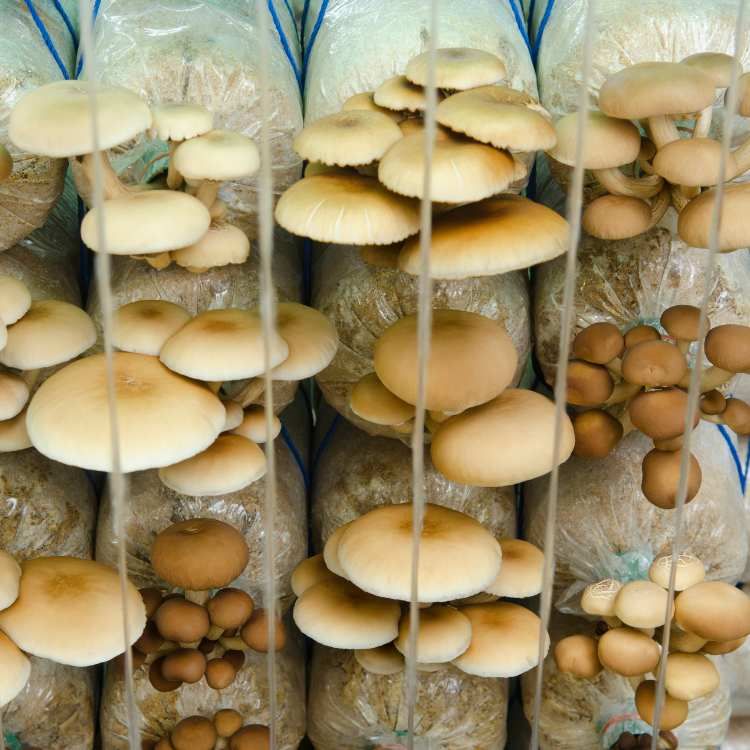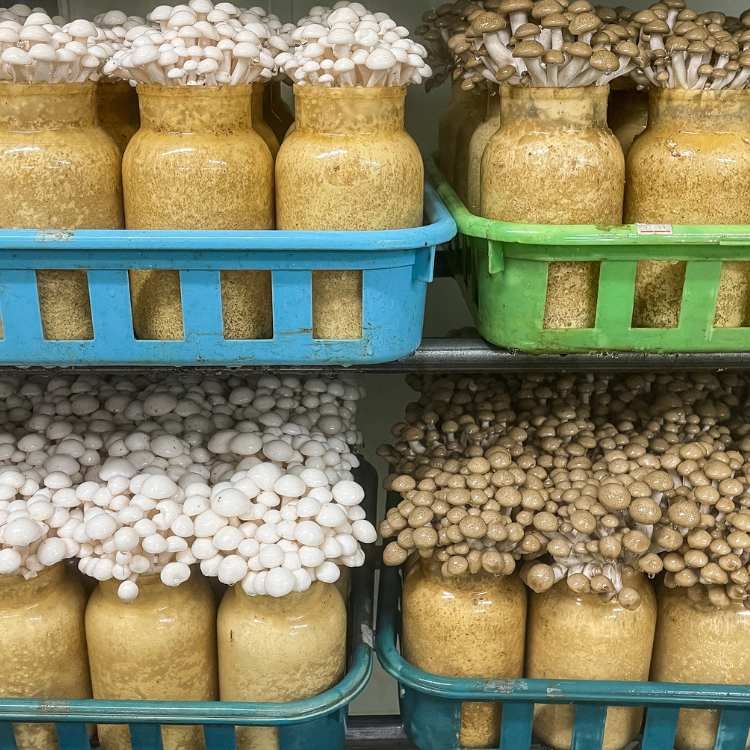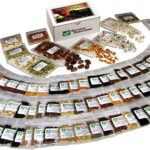
Key Takeaways
Indoor mushroom cultivation is a perfect project for apartment dwellers with limited space.
Shiitake, oyster, and white button mushrooms are great varieties for beginners to grow.
Common substrates for growing mushrooms include sawdust, straw, and coffee grounds.
Essential equipment includes containers, a spray bottle for misting, and a space to maintain the correct temperature and humidity.
By following simple steps, you can harvest your own mushrooms in just a few weeks.
Why Grow Mushrooms Indoors?
Imagine having a constant supply of mushrooms right at your fingertips, no foraging necessary. That’s the beauty of indoor mushroom cultivation. It’s not only a fun and rewarding hobby but also a great way to ensure you have fresh, organic produce even in the smallest of apartments.
Great for Small Spaces
Most importantly, growing mushrooms indoors doesn’t require a backyard or large space. With just a corner of your kitchen or a small section of your living room, you can set up a mini mushroom farm. Because mushrooms grow in vertical containers or bags, you can make the most of your vertical space too.
Therefore, even if you’re living in a cozy studio apartment, you can still be a successful urban gardener. All you need is a little bit of ingenuity and the right conditions, and you’ll be harvesting mushrooms in no time.
Nutritional and Medicinal Benefits
Mushrooms are not just delicious; they’re packed with nutrients like vitamin D, selenium, and antioxidants. Besides that, certain varieties like the reishi mushroom are known for their medicinal properties, which can boost your immune system and may even have anti-cancer benefits.
For instance, shiitake mushrooms have been shown to contain compounds that improve heart health and boost immunity.
Therefore, by growing your own mushrooms, you’re taking a step towards a healthier lifestyle right from your apartment.
Eco-Friendly and Sustainable
Besides their health benefits, mushrooms are also incredibly sustainable. They require less water and space than traditional crops, and they can be grown on a variety of substrates that might otherwise be considered waste, like coffee grounds or sawdust. This makes them an eco-friendly addition to your urban gardening efforts.
Choosing Your Mushrooms
Before diving into the world of mushroom cultivation, it’s essential to choose the right varieties for your space and skill level.
Best Varieties for Beginners
When starting out, it’s best to opt for varieties that are more forgiving and easier to grow. Here are some top picks:
Oyster Mushrooms: Known for their rapid growth and minimal care requirements.
Shiitake Mushrooms: Prized for their flavor and health benefits, these mushrooms thrive on hardwood substrates.
White Button Mushrooms: The most commonly consumed mushroom variety, perfect for beginners.
Each of these varieties can provide a bountiful harvest with the right care and conditions.
Understanding Different Mushroom Substrates
Mushrooms aren’t grown in soil like most plants; they require a substrate – a substance they can grow on and extract nutrients from. Here’s a quick rundown:
Sawdust: Perfect for varieties like shiitake and oyster mushrooms.
Straw: Another excellent choice, particularly for oyster mushrooms.
Coffee Grounds: A great way to recycle your morning coffee, and ideal for growing oyster mushrooms.
Choosing the right substrate is crucial because it directly affects the growth and yield of your mushrooms.
Setting Up Your Space

Now that you know why to grow mushrooms indoors and what types to start with, it’s time to set up your growing space. You don’t need a lot of room; a small, controlled environment will do.
First, identify a space in your apartment that can maintain a consistent temperature and humidity level. Mushrooms thrive in a cool, moist environment, typically around 55-60°F with high humidity.
Essential Equipment List
Here’s what you’ll need to get started with growing mushrooms indoors:
Containers or grow bags
A spray bottle for misting
A thermometer and humidity gauge
A heating pad or mat (if necessary to maintain temperature)
A fan for air circulation
With these tools in hand, you’re ready to embark on your mushroom growing adventure. Stay tuned for the next steps, including how to plant your mushroom spores and care for your growing fungi.
With your space ready and the perfect mushroom variety selected, it’s time to get your hands dirty—or rather, your substrates inoculated. Here’s how you can get started with planting your mushroom spores or spawn.
How to Plant Mushroom Spores
To begin, you’ll need either mushroom spores or spawn. Spores are like the seeds of the mushroom world, but they can be a bit trickier to handle. Spawn, on the other hand, is like the starter dough of mushroom growing—mycelium that’s already begun to grow. For beginners, I recommend starting with spawn for a more straightforward experience.
Here’s the step-by-step process:
Sterilize your substrate by heating it or using a chemical sterilizer to kill any unwanted bacteria.
Once cooled, mix the spawn with the substrate, ensuring even distribution.
Place the mixture in your container or grow bag.
Maintain the correct temperature and humidity levels, and wait for the mycelium to colonize the substrate fully. This could take a couple of weeks.
Patience is key here. The mycelium is the foundation of your mushroom growth, so give it the time it needs to develop a strong network.
Day-to-Day Mushroom Care
Once your substrate is fully colonized, the real fun begins. Mushrooms need a moist environment to thrive, so daily misting with a spray bottle is essential. But be careful not to overdo it—too much water can lead to mold and bacterial growth.
Keep an eye on the temperature and humidity levels, adjusting as necessary. If you notice any off smells or discolored mushrooms, remove them immediately to prevent the spread of potential contaminants.
Remember, fresh air is crucial for mushroom development. So, ensure your growing space is well-ventilated to provide your mushrooms with the oxygen they need.
Harvest Time and Uses
After nurturing your mushrooms with daily care, you’ll eventually reach the most exciting part—harvest time. But how do you know when they’re ready?
Knowing When to Harvest
Harvest time can vary depending on the mushroom variety, but generally, you’ll want to pick them just as the caps begin to open up, right before they start to release their spores. Gently twist and pull the mushrooms from the substrate, taking care not to damage the mycelium beneath.
Harvesting at the right time not only ensures the best flavor and texture but also encourages more mushrooms to grow in their place. For more tips on maximizing your yield, check out our guide on compact fruit trees for your survival garden.
From Garden to Kitchen: Enjoying Your Mushrooms
Once harvested, your mushrooms are ready to be cleaned and enjoyed. Brush off any substrate particles, give them a quick rinse if needed, and they’re ready to be cooked up in your favorite recipes. Imagine adding your own homegrown shiitake mushrooms to a stir-fry or topping your pizza with freshly picked oyster mushrooms—delicious!
And let’s not forget the pride that comes from knowing you’ve grown these tasty morsels yourself. From garden to kitchen, the journey of indoor mushroom cultivation is a rewarding one.
Long-Term Maintenance
One of the joys of mushroom cultivation is that it can be a continuous process. With the right maintenance, you can enjoy multiple harvests from the same setup.
Continual Harvest Strategies
After your first harvest, give the substrate a rest for a week or so, then resume misting. You should see new mushrooms begin to form. This cycle can be repeated several times, though eventually, the nutrients in the substrate will be depleted, and it’ll be time to start fresh.
To extend the life of your mushroom garden, consider adding fresh substrate or spawn after a few cycles to rejuvenate the growing environment.
Dealing with Common Issues
Like any garden, an indoor mushroom setup can encounter issues. Common problems include mold, pests, and poor mushroom development. To combat these, ensure your growing area is clean, avoid over-misting, and remove any affected mushrooms immediately.
If problems persist, it may be time to reassess your setup and make adjustments to your temperature, humidity, or ventilation strategies.
Selecting for Quality: Top Mushroom Growing Kits
If starting from scratch seems daunting, don’t worry. Mushroom growing kits are a fantastic option that can simplify the process.
The Value of Pre-Made Kits
These kits come with everything you need—pre-inoculated substrate, a container or bag, and instructions. They’re a great way to dip your toes into the world of mushroom cultivation without worrying about the nitty-gritty details of starting from spores or spawn.
Survival Essentials’ Top Growing Kit Choice
For those ready to embark on their mushroom growing journey, Survival Essentials offers an excellent selection of growing kits. Whether you’re a fan of shiitake, oyster, or any other variety, you’ll find a kit that suits your needs. Check out their collection at Survival Essentials to find your perfect match.
With a pre-made kit, all you need to do is follow the included instructions, and before you know it, you’ll be harvesting your own mushrooms right from your apartment.
Ready to get started? Grab your mushroom growing kit today and join the ranks of urban gardeners who’ve discovered the joy of growing their own food, no matter the size of their space.
Take the Leap: Start Your Mushroom Cultivation Journey Today
Embarking on your mushroom cultivation journey is a leap towards sustainability, self-sufficiency, and a deeper connection with your food. With the right approach, anyone can transform their apartment into a miniature mushroom farm. It’s a simple yet profound step that not only brings the delight of harvesting your own produce but also introduces a unique, earthy element to your urban dwelling.
Step-by-Step Guide to Your First Cultivation
Let’s break it down into manageable steps to ensure your first mushroom cultivation is a success:
Choose your mushroom variety based on your taste preference and growing conditions.
Select a spot in your apartment that maintains a consistent temperature and is out of direct sunlight.
Gather your supplies: a growing kit or the necessary equipment for a DIY setup.
Follow the instructions for planting and caring for your chosen mushroom variety.
Mist your mushrooms daily to maintain the humidity they love.
Harvest your mushrooms at the right time to enjoy the freshest flavors.
With these steps, you’re well on your way to becoming an urban mushroom gardener. It’s a process filled with learning and growth, and most importantly, it’s a lot of fun!
Ready to Grow? Purchase Your Starter Kit
Are you excited to start growing mushrooms but not sure where to begin? A starter kit is the perfect solution. It’s designed to make the process straightforward and enjoyable, especially for beginners. Survival Essentials offers a range of kits to get you started. Choose one that appeals to you, and take the first step towards your mushroom growing adventure.
Frequently Asked Questions (FAQ)
Can I Grow Mushrooms in Any Indoor Space?
Absolutely! Mushrooms are incredibly adaptable and can be grown in almost any indoor space. All they need is a cool, dark, and humid environment to thrive. With the right setup, you can grow mushrooms in a closet, on a bookshelf, or even in a drawer. For more information on creating your own city oasis, check out our urban gardening tips.
Do I Need Specialized Equipment to Start?
Not necessarily. While certain equipment can make the process easier, many mushroom growers start with just a simple container, a spray bottle for misting, and a growing medium. Of course, a mushroom growing kit from Survival Essentials can simplify the process even further, providing you with all the necessary components.
How Long Does it Take for Mushrooms to Grow?
Most mushroom varieties will start to fruit within a few weeks of setting up your grow. However, the exact timing can vary based on the type of mushroom, the conditions of your grow space, and how well you’re able to maintain the required environment for your fungi friends.
What are the Potential Health Benefits of Homegrown Mushrooms?
Homegrown mushrooms are a powerhouse of nutrients, including protein, vitamins, and minerals. They’re low in calories and high in fiber, making them a healthy addition to any diet. Plus, by growing them yourself, you can be sure they’re free from pesticides and other chemicals often found in commercially grown varieties.
Are Mushroom Growing kits Worth the Investment?
For many first-time growers, mushroom growing kits are definitely worth the investment. They reduce the guesswork and provide everything you need for a successful harvest. If you’re looking for a kit, check out the options available at Survival Essentials, where you can find a curated selection of high-quality mushroom growing supplies.







Leave a Reply